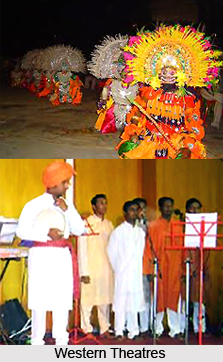Folk Theatre of West India lays bare the western cultural panorama. Povada is a kind of Marathi ballad that describes the heroic deeds by great kings. Its origins lie in Vedic literature. It can be explained as the Aittariya Brahmana contains songs in praise of Indra. Povada is similar to Birmal sung by Charan Bhats in Rajasthan. Probably, it came with them when they migrated from the north and settled down in Maharashtra during Shivaji`s time. The earliest Povadas belong to the sixteenth century. The famed Agindas composed Povadas on thrilling incidents from Shivaji`s life. The word may also be associated with the pavad ritual in which devotees of Khandoba break iron chains inspired by love of God.
 The Povada is essentially a narrative tale, composed in 4 to 40 chauk i.e. stanzas of three or four lines. The presenter dresses in angarakha or long and loose upper garment and salwar with a cummerbund. The presenter also wears a tall kanganidar pagri orpheta or turban on his head and carries the halgi or daph i.e. tambourine, which he plays. He is the coordinating force, acts as the hero, and also narrates as the sutradhara. His companions, called jhilkari, play the minor characters and provide musical, vocal, and instrumental support. The Povada begins with the gana, a prayer-song invoking the god Ganesha. The narration proceeds in poetry and prose, and the jhilkaris join in the refrain or repeat certain lines, and also offer appropriate responses.
The Povada is essentially a narrative tale, composed in 4 to 40 chauk i.e. stanzas of three or four lines. The presenter dresses in angarakha or long and loose upper garment and salwar with a cummerbund. The presenter also wears a tall kanganidar pagri orpheta or turban on his head and carries the halgi or daph i.e. tambourine, which he plays. He is the coordinating force, acts as the hero, and also narrates as the sutradhara. His companions, called jhilkari, play the minor characters and provide musical, vocal, and instrumental support. The Povada begins with the gana, a prayer-song invoking the god Ganesha. The narration proceeds in poetry and prose, and the jhilkaris join in the refrain or repeat certain lines, and also offer appropriate responses.
Gambhira is a folk musical theatre in Bengal. Some part of the Gambhira festival dedicated to Siva from April to June in and around Maldah district. The festival features a large body of rituals, ceremonial processions, and masked dances as in the other variations of Gajan. Gajan is the Siva festival celebrated in mid-April all over Bengal. Growing out of its earlier form, Bolbahi or Bolbai, which centred more directly on local characters and scandals, and often faced resistance from its targets, Gambhira underwent a transformation with nationalist intervention in the early twentieth century. The new style, often performed before an image of Siva installed in a hut open on three sides, begins with a chorus, usually of four singers, invoking him.
Shiva appears in his popular manifestation, bare-bodied with matted hair and tiger skin around his waist, to listen to complaints. Shiva is frequently presented through a series of satiric skits illustrating situations of denial and deprivation, and accusing the authorities, both local and national as well. Shiva was a sympathetic listener, sometimes visits the authorities to plead the villagers` cases, albeit with little effect. The performers represent several vocations, classes, and castes, projecting what a British administrator-surveyor described officially in 1918 as an `annual review of the acts of the year and penance for misdeeds`. Siva remains essentially a friend of the common people and a wise guardian, addressed familiarly as nana or grandfather. Several Gambhira troupes operate during the season, and even beyond at folk festivals sponsored by the state government or other organizations, the strong topicality of their themes and the subjects of their songs helping them to retain their popularity.
The term Khyal is possibly derived from khel, or `to play`, in the sense of playing drama. This is actually a popular folk form of Rajasthani theatre influenced by Parsi theatre. This form is not very ancient, but it is only about a hundred years old. The three varieties of Khyal namely Alibuxi, Shekhawati, and Kuchamani are associated with three playwrights. The names can be mentioned as Alibux, Nainuram during 1823-1905, and Lacchiram respectively. They were near-contemporaries and great frequenters of Parsi companies. As they wrote for troupes travelling to villages, where halls were not available, they changed what they saw to suit their purpose, dispensing with the elaborate settings and other heavy trappings of Parsi theatre to make Khyal relatively simple.
The plays are usually performed in open spaces using wooden platforms. The name is takhat, which is easily available in every village. This is about 1 m high, with spectators sitting on three sides. In more elaborate multi-level shows, separate mahal i.e. palace or jharokha i.e. window platforms are erected. This is up to 6 m off the ground, representing different locales. There are no curtains, the actors enter in full view of the audience and, having performed their part, sit down beside the musicians. Subsequent entries are made from that very spot. Women`s roles are played by men, one of the foremost female impersonators being Ugamraj Khilari. Music is extremely important. The dialogue, written in verse, is sung by the characters to the main accompaniment of nagarra or kettledrum and harmonium. The style of singing differs in many cases. Alibuxi Khyal mixes classical and folk, in Shekhawati the music is pure classical, and in Kuchamani it is folk.




















